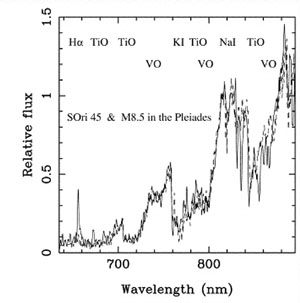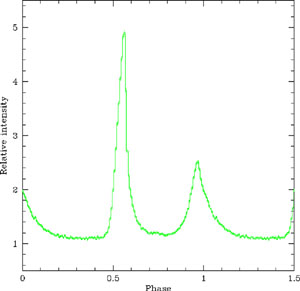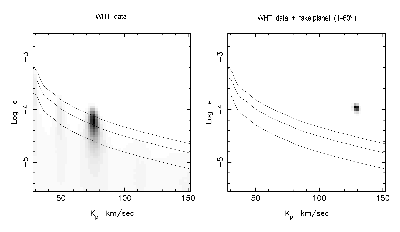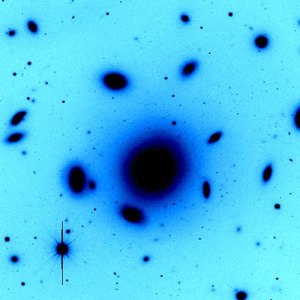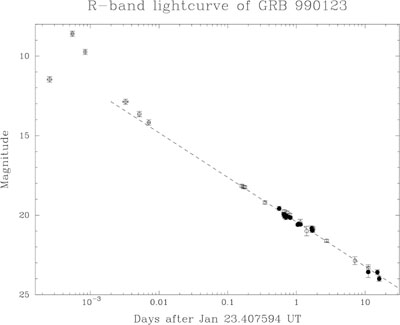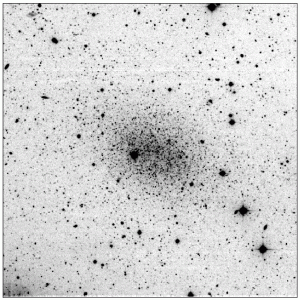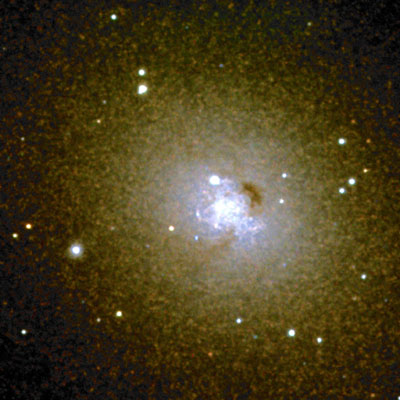 | |||
|
| Home > Public Information > Scientific Highlights > 1999 |
|
in 1999* *Astronomical discoveries following from observations carried out with the ING telescopes
[ STARS, EXTRASOLAR PLANETS AND THE GALAXY | EXTRAGALACTIC | OBSERVATIONAL COSMOLOGY | OTHER SCIENTIFIC HIGHLIGHTS BRIEFLY ] The following presents a selection of highlights, intended to be representative of the scientific quality and range of research being undertaken. |
HIGH VELOCITY CLOUDS WHT+UES Scattered across the sky are hundreds of clouds of hydrogen gas, moving at such high velocities that they clearly stand out from the usual interstellar material in the Milky Way. These high-velocity clouds (HVCs) have remained enigmatic since their discovery in the 1960s. HVCs have velocities inconsistent with simple Galactic rotation models that generally fit the stars and gas in the Milky Way disk. Their origins and role in Galactic evolution remain poorly understood, largely for lack of information on their distances. The HVCs might result from gas blown from the Milky Way disk into the halo by supernovae, in which case they would enrich the Galaxy with heavy elements as they fall back onto the disk. Alternatively, they may consist of metal-poor gas - remnants of the era of galaxy formation, accreted by the Galaxy and reducing its metal abundance. Or they might be truly extragalactic objects in the Local Group of galaxies. Distance estimates of HVCs have long been based on models or indirect arguments. The only direct method uses the presence or absence of interstellar absorption lines at the HVC's velocity in spectra of stars at different distances. The presence of absorption shows the HVC to lie in front of the star; absence places it beyond, provided that the expected absorption is well above the detection limit. So far distance measurements are lacking. HVC complex A, also called chain A, was the first HVC discovered and has been studied in detail. It is a 30º-long filament, containing several well-aligned concentrations with velocities between -210 and -140 km/s. Spectra from the Hubble Space Telescope set a firm lower distance limit, d>4±1 kpc for chain A. Astronomers have now also measured an upper limit, d<10 kpc, for the upper end of chain A, using UES spectra of the the RR Lyrae star AD Ursae Majoris. This is the first time a firm distance bracket for a large high-velocity cloud is obtained. According to this distance bracket, chain A is placed in the Milky Way halo (2.5 to 7 kiloparsecs above the Galactic plane), rather than at an extragalactic distance, and its mass is constrained to between 105 and 106 solar masses. The obtained distance bracket excludes models for its nature and origin requiring a distance of the order of 1 kpc or less, such as relationships to local molecular clouds, or collision of an intergalactic cloud with the Galactic disk. It also rules out chain A being a Galactic satellite at ~50 kpc distance, or a protogalactic gas cloud at ~500 kpc distance, or a member of the Local Group of galaxies, as proposed recently for HVCs in general. The location of chain A in the Galactic halo still allows several models for its origin. For its height 2.5 < z < 7 kpc to be consistent with a Galactic-fountain model, a sufficiently hot halo would be required. The small-scale structure observed in chain A would then be due to instabilities formed in the downward flow of cooling clouds. Alternatively, chain A may represent gas captured from intergalactic space. In that case, collision with an ionized halo extending high above the Galactic plane may have served to decelerate the gas to its present velocity, and to form the small-scale structure. In this accretion model, the question whether the origin of chain A lies in the Magellanic system (as debris from encounters between Milky Way and Magellanic Clouds), or far away in the Local Group (as remnant of Local Group formation), remains open: location in the Galactic halo does not preclude such a distant origin. Some references:
WHT+ISIS, +WHIRCAM, INT+WFC, +PFC Stellar clusters and associations offer a unique opportunity to study substellar objects in a context of known age, distance, and metallicity; they are laboratories of key importance in understanding the evolution of brown dwarfs. Deep- and wide-imaging surveys to search for low-mass objects have continued on the ING telescopes. Such surveys can probe the cluster luminosity and mass functions down to the substellar limit, and beyond in the case of the nearest and youngest open clusters. In particular, the Pleiades, a star cluster which is an ideal hunting ground for substellar objects mainly due to its richness of members, young age, proximity and scarce interstellar absorption, have revealed a large population. Recently, about 45 brown dwarf candidates have been discovered. The extension of these studies to other clusters, especially in the younger regions, is therefore very important for confirming and enlarging these results. With this intention a survey in the young stellar cluster around the young multiple star sigma Orionis was carried out. The cool nature of eight candidates (spectral types M6-M8.5) was spectroscopically confirmed. One of the latest type candidates, S Ori 45 (M8.5), is one of the least massive objects known to date, with a best estimate of its mass at 0.020-0.025 solar masses. Praesepe is a nearby and rich Galactic
open cluster within the Hyades moving group. Though similar to the Hyades
in terms of age, kinematics and chemical composition, Praesepe's larger
distance and smaller angular extent make it an excellent target for wide-area
CCD surveys. However, the brown dwarf population of Praesepe is sensitive
to both the age and distance of the cluster. If the cluster is 500 Myr
old, then a recent survey would have found 3 good candidates. But if the
cluster is 1 Gyr old, then only one might be a brown dwarf.
Some references:
WHT+SCAM A totally new concept in optical detector instrumentation made its first appearance at the WHT. The Super-conducting Tunnel Junction camera (S-CAM), designed and built by members of the Astrophysical Division of the European Space Agency, is a high-efficiency photon-counting system which provides position and arrival time of each detected photon, along with the photon energy. A tunnel junction consists of two conductors separated by a tiny gap of insulating material or even a vacuum. If the gap is thin enough, electrons can tunnel across anyway, and if the conductors are superconductors, the junction displays very useful quantum-mechanical properties and electrical nonlinearities. An arriving photon breaks apart the pairs of electrons responsible for the superconducting state, which can then be collected. Each individual photon creates a large number of free electrons, in proportion to photon energy. Thus by measuring the charge released by each detected photon, these can be sorted in energy, or wavelength. The main advantages of STJs is that they operate at high speed at very low temperatures, dissipate very little power and are very small. The first observations of an astronomical object using an STJ device took place at the William Herschel Telescope in February 1999. The Crab pulsar was observed using a 6 × 6 array of Tantalum STJs, covering an area of about 4 × 4 arcsec2, cooled with the help of a bath of liquid helium to a temperature within a degree of absolute zero. This object, a neutron star spinning about 30 revolutions per second and one of the few pulsars that is known to emit optical pulses, was an ideal target for verifying the STJ camera's photon counting and timing capabilities. The astronomers recorded a light curve for the pulsar in two bands simultaneously over the wavelength range 310-610 nm, based on data acquired over a ten-minute interval, with an arrival-time accuracy of 5µs. The light curve clearly shows the characteristic two beams of light which shine out, like a lighthouse, one weak and long and the other bright and short, in each revolution. The color didn't change through the pulses. The astronomical impact of these
results may have been modest, but it has presented a glimpse of what STJ
technology holds in store for the future.
Some references:
P Moore, N Rando, 1999, "Super Cool Technology", ING Newsletter, 1, 13. THE SEARCH FOR REFLECTED LIGHT FROM EXTRASOLAR PLANETS WHT+UES The search of extrasolar planets is one of the major quests in the history of the humanity. Since the first extrasolar planet was detected in 1995, at least 30 more planets have been found. Their detection relies on the fact that the force of gravity that keeps a planet in its orbit has an opposite reaction on the star, causing it to wobble in its own tiny orbit about the common centre of mass. From the size of the stellar wobble, astronomers can calculate a lower limit for the planet's mass, but they can't tell whether they are seeing the effect of a lighter planet in an orbit seen edge-on, or a heavier one in the same orbit viewed differently. This indirect detection cannot tell us anything about the composition of these planets either. All the stellar wobbles indicating extrasolar planets have so far been found using the Doppler technique, which measures changes in the star's velocity along the line of sight. More recently the transit method has succeeded in finding the first extrasolar planet. This method relies on the detection of the transit of the extrasolar planet across the face of its host star, which astronomers use to estimate the planet's size, mass and density. The high-resolution UES spectrograph
on the WHT has been used to go further and detect direct light from an
extrasolar planet. The idea is to look for light with a different Doppler
shift than that of the star itself. However, the detection of reflected
light is very difficult. It requires extremely careful data reduction techniques
to be applied to the data, in order to extract the very faint light signal
from the planet. In late 1999 astronomers using this method claimed to
have discovered the probable detection of Doppler-shifted starlight reflected
from the planet known to orbit Tau Boötis with a period of just a
few days. They found that the orbital inclination was about 29º, from
which they inferred that the mass is about eight times that of Jupiter.
The planet has the size and reflectivity expected for a gas-giant planet.
Some references:
WHT+UES Hypergiants are supergiant stars with strongly developed large-scale atmospheric velocity fields, excessive mass loss, and extended circumstellar envelopes. They are rare objects, only 12 of them being known in our Galaxy. There are indications that yellow hypergiants are evolved stars, evolving from the red supergiant phase to the blue phase. However, stars with effective temperature near 9,000 K have density inversions, which may indicate instability. This has led to research on the 'yellow evolutionary void'. Inside the void the atmospheres are moderately unstable. The process of approaching the void has not yet been studied and this is a field in which no observations have guided theory so far. A monitoring of stars approaching the void will help to understand the nature of the instabilities and the hydrodynamics of unstable atmospheres and finally to answer the most important question of whether or not these stars can pass the void. It is believed that the Galactic hypergiant HR 8752 is presently bouncing against the yellow evolutionary void. From UES spectra astronomers reported for the first time the finding of spectroscopically recorded large changes of the effective temperature, from 5,000 K in 1969 to about 8,000 K in 1998, which cannot be ascribed to the regular variability of a supergiant atmosphere. This finding is based on a unique combination of high-resolution optical spectra that span a period of about 30 years. Thus, HR 8752 turns out to be the first cool supergiant that shows the effects of stellar evolution from a study of its 30 year old spectroscopic history. Now that HR 8752 approaches the yellow evolutionary void three possibilities arise: 1) The star might return to the point when the effective temperature was 4,000-5,000 K; 2) It might explode as a supernova or, 3) It might occupy the void, which would mean that theory should change. Observations in the coming years will tell us the next evolutionary stage. Some references:
WHT+UES, +ISIS, JKT+CCD Among the faint, blue stars that are observed at intermediate and high Galactic latitudes, there exists a small subset of objects that are spectroscopically indistinguishable from normal, young Population I B-type stars found in the Galactic disk. The majority of this subset are plausible 'runaway' stars, recently formed in the Galactic disk and subsequently ejected by some mechanism. However, in a few cases these apparently normal stars are found at large distances from the Galactic disk, and their evolutionary ages are too short for the objects to have attained their current Galactic locations. There is no doubt that star formation at large distances from the Galactic plane is controversial. However, shock induced star formation between halo high velocity clouds has been postulated as the origin of the apparently young, distant B-type stars where formation in situ seems to be the only possible explanation for their existence. From recent echelle spectroscopy of 21, apparently normal, high Galactic latitude, early-type stars of solar metallicity drawn from the Palomar-Green survey, astronomers concluded that distances, ages, and velocities are consistent with escape from the Galactic plane. In other words, all these objects are 'runaway' stars, formed in the Galactic disk and subsequently ejected, possibly by supernovae explosions or dynamical interactions. In particular high-resolution, high signal-to-noise ratio spectra of HD 100340 showed that this is a normal main-sequence B-type star, at a distance of 2.6 kpc above the Galactic plane. A kinematical analysis strongly suggests that HD 100340 formed in the Galactic disc, and was subsequently violently ejected towards the halo, as a result of the dynamical evolution of a stellar cluster. Some references:
|
|||||||||
COSMIC FLOW OF GALAXIES ACROSS ONE BILLION LIGHT YEARS OF THE UNIVERSE INT+IDS, JKT+CCD According to the 'cosmological principle', the large-scale Universe should be smooth and well behaved. Distant galaxies ought to be evenly distributed in space, and their motions should correspond to a pure 'Hubble flow', a uniform expansion of space in all directions. In other words, the Universe, in some average sense, is homogeneous and isotropic. But galaxies have other "peculiar velocities", over and above the general cosmic expansion. Although the cosmological principle is one of the central tenets of cosmological theory, it is obvious that the Universe is not exactly homogeneous and isotropic. Matter is not smoothly distributed, but organized into galaxies, galaxy clusters and even superclusters of galaxy clusters. This complex hierarchy of density fluctuations is, according to 'inflation theory', a result of the gravitational amplification of low-amplitude 'ripples' that were present in the very Early Universe. But there should be a scale beyond which gravity has not had sufficient time to produce structures, and beyond which the Universe should therefore appear homogenous. Besides generating spatial patterns, gravity also generates velocities. In a perfectly uniform universe, everything moves away from everything else with a velocity that is proportional to the distance between. This is known as the Hubble law. But the presence of density fluctuations distorts this uniform Hubble flow by introducing peculiar motions. All galaxies execute some kind of peculiar motion, as a consequence of the gravitational influence of the lumpy distribution of material around them. In the densest galaxy clusters - known as Abell clusters - where gravitational forces are very strong, galaxies move around with peculiar velocities of ~1,000 km/s generated by the deep potential well in which they reside. On scales larger than individual clusters, the concerted action of entire superclusters produces a calmer, more coherent flow towards regions of above-average density, and away from regions of below-average density. These 'streaming' motions contain clues to the size of the largest structures doing the pulling and thus furnish an important test of cosmological models. In 1988, a study of streaming motions in a sample of elliptical galaxies revealed evidence for a systematic flow, simple modelling of which suggested that it could be explained by a hypothetical object about 60 megaparsecs away from the Milky Way, which became known as the 'Great Attractor'. To map cluster motions, astronomers have to work out how much their velocity - easy to determine from redshift - departs from the velocity that the overall cosmic expansion would give to an object at that distance. That means determining their distance without relying on redshift, a much tougher requirement. The usual strategy is to find some observable feature of galaxies that is thought to indicate their actual brightness or size, then compare it with the brightness or size observed from Earth to get distances. The Streaming Motions of Abell Clusters (SMAC) Collaboration looked at elliptical galaxies and determined their absolute size by measuring the mean surface brightness in the central part of the galaxy and how fast stars are darting around within it - indicated by the broadening of spectral lines. Then they compared these to similar known galaxies close to Earth. They applied the constructed distance indicator to about 700 galaxies in 56 rich clusters spanning a volume some 1.2 billion light years in diameter. Many telescopes were used in this survey, including the INT and the JKT. The SMAC survey went far beyond the
proposed location of the Great Attractor and they still see outward motion
of galaxies beyond it. The reported bulk flow is of amplitude 630±200
km/s with respect to the cosmic microwave background. This flow is robust
against the effects of individual clusters and data subsets, the choice
of Galactic extinction maps, Malmquist bias, and stellar population effects.
The direction of the SMAC flow is about 90º away from the flow found
by other astronomers, but it is in good agreement with the gravity dipole
predicted from the distribution of X-ray-luminous clusters.
Some references:
WHT, INT, JKT In 1999 the ING telescopes discovered and followed up more optical afterglows of gamma-ray bursts, like the extremely intense GRB 991208 (IAU Circ 7332). Moreover, the observations carried out by the ING telescopes have been used to shed new light on the understanding of these objects (see for instance: F J Castander, D Q Lamb, 19999, "A photometric investigation of the GRB 970228 afterglow and the associated nebulosity", ApJ, 523, 593; A J Castro-Tirado, J Gorosabel, 1999, "Optical observations of GRB afterglows: GRB 970508 and GRB 980326 revisited", A&A Suppl., 138, 449; N Masetti et al., 1999, "Broad-band spectral evolution of GRB afterglows", A&A Suppl., 138, 453; J Gorosabel et al., 1999, "Early detection of the optical counterpart to GRB 980329", A&A, 347, L31; F A Harrison et al., 1999, "Optical and radio observations of the afterglow from GRB 990510: Evidence for a jet", ApJ Letters, 523, 121). Below we extend on two interesting topics relates to GRB research: JKT+CCD Gamma-Ray Bursts (GRB) are believed to be the largest explosions in the universe since the Big Bang. However, the origin of these bursts have remained a mystery since their discovery more than 30 years ago. The bursts occur almost daily and shine at least a billion times brighter than any other phenomenon in the universe, including quasars. The bursts last anywhere from a few milliseconds to several minutes, then disappear forever. The bursts are followed by afterglows that are visible for a few hours or days at other wavelengths. GRBs are thought to arise when an extremely relativistic outflow of particles from a massive explosion interacts with material surrounding the site of the explosion. Multi-wavelength observations, following their light-curves, are needed to understand the nature of the explosions. The time scale of the decay since the gamma-ray explosion is detected is about 10 days: the brightness of the optical counterpart can decrease about fifteen magnitudes over this period. Therefore, a quick and accurate determination of the position of the optical counterpart and the follow-up photometry of the source is crucial, which requires a global observing campaign, involving many telescopes. On 23 January 1999 one of the brightest GRBs ever seen was detected by the BATSE satellite. For the first time, observations at optical, infrared, sub-millimetre and radio wavelengths were obtained of an entire gamma-ray burst. In this effort the JKT was involved, contributing to the photometric light-curve at multiple wavelengths. These observations revealed that the optical and gamma-ray light curves are not the same. This was also the first time that the three different regions involved in the emission process were seen: the internal shocks causing the GRB, the reverse shock causing the pronounced optical flash, and the forward shock causing the afterglow. If the blast radiated the same amount
of energy in all directions as it did towards Earth, its energy would be
equivalent to that of almost two neutron stars and irreconcilable with
current theories of gamma-ray bursts. However, the speed at which the radiation
faded over the following two days suggests that material was ejected from
the explosion in two cones, one of which pointed towards the Earth. This
would make it easier to explain gamma-ray bursts by conventional mechanisms
such as the shock waves formed following the death of a massive star.
References:
WHT+PFC, INT+WFC The discovery of both an X-ray and optical afterglow to GRB 970228 by the WHT and INT revolutionised the study of gamma-ray bursters. The mean temporal and spectral properties of this afterglow appeared to be consistent with the relativistic fireball model. However, now that more data has been gathered on several gamma-ray bursts, not all of them appear to fit the fireball model. One of them is GRB 970228. Studies of this gamma-ray burst, including observations from the WHT and INT, found evidence of extreme reddening of the afterglow with time, which is difficult to explain in the fireball model. Re-analysing the light-curves of the afterglow at different wavelengths suggested a link with a possible rare type of supernova explosions, which strengthens ideas that at least some type of gamma-ray bursts are produced following the collapse of a massive star. Some references:
WHT+ISIS Several lines of evidence suggest that Active Galactic Nuclei (AGNs) are powered by accretion onto super-massive black holes. The much higher volume-number density of AGNs observed at redshift z ~ 2 than at z ~ 0 suggest that many quiescent (or 'normal') galaxies today must have gone through an active phase in the past, and therefore harbour a massive black hole as well. Such a black hole will significantly influence the dynamics of the galaxy within a certain distance, imposing conditions to the profile of the velocity dispersion of the stars surrounding this massive object. Taking into account these theoretical predictions a study was undertaken of the lenticular (type-S0) galaxy NGC 4342. This study involved a combination of HST and WHT imaging and spectroscopy. The data obtained from these observations were compared with theoretical models describing the dynamics and morphology of the galaxy. Spectra obtained with the WHT have revealed a very steep central rotation curve and a strong central increase in velocity dispersion. These data suggest a large central mass concentration. However, although the dynamical evidence for the presence of a massive dark object in NGC 4342 is compelling, it does not automatically imply evidence for a black hole. If it exists, the mass of the super-massive black hole must be approximately between 3 and 6 x 108 solar masses. Then NGC 4342 would have one of the highest ratios of black-hole mass to bulge mass. Some references:
INT+WFC The observational universe is built mostly from galaxies. For obvious reasons, most of the known (detected and catalogued) galaxies are intrinsically the largest and brightest ones, those which can be seen from the greatest distance and are most easily studied. Dwarf galaxies, however, dominate numerically in any volume-limited sample, and were probably even more numerous in the cosmological past. Despite their unassuming appearance dwarf galaxies hold the key to many questions of galaxy formation, structure and evolution. They also provide important constraints on the distribution and nature of dark matter, and star formation in low density environments. The need for more data in all these matters, together with the relatively few known dwarf galaxies, make a search for more of them very worthwhile. However, almost by definition dwarf galaxies are difficult to detect and observe. Searches for dwarf galaxies have been carried out in nearby galaxy groups with good results. However, owing to their small intrinsic size, dwarfs in external groups are difficult to characterize morphologically, and it is only within and near the Local Group that the resolved stellar photometry necessary for construction of detailed star formation histories can be obtained. Thus it appears most promising to limit a search to the Local Group and its immediate environs. To this end a visual examination of all 894 fields covered by the ESO-SRC and SERC Equatorial surveys of the southern sky was performed. Objects resembling the Andromeda dwarf spheroidals and the Tucana dwarf, that is of very low surface brightness (VLSB), diffuse and large (1 to a few minutes of arc), were noted. Some of the more northerly candidates were followed up using the Wide Field Camera (WFC) on the Isaac Newton Telescope. Candidates were initially examined
by taking short exposures in the R band. With good seeing this enables
stellar objects to R~23 to be detected. At this depth objects close to
or within the Local Group should begin to resolve into stars, with the
tip of the giant branch becoming readily visible. If a candidate appeared
to resolve into stellar components, further broadband observations in V
and I together with narrow-band H-alpha were obtained. The initial exposure
of an uncataloged object in the constellation Cetus, at RA = 00h26m11.0s,
DEC=-11º02´40" (J2000), showed a diffuse swarm of faint stars.
Further exposures were taken in order to characterise the new object.
The Cetus dwarf has a smooth, diffuse appearance and appears to be a dwarf spheroidal of type dE3.5. A color-magnitude diagram in V, V-I shows a clear giant branch but no sign of recent star formation. From the position of the tip of the giant branch, a reddening-corrected distance modulus of 24.45 ± 0.15 and a metallicity of -1.9 ± 0.2 is derived. With an implied heliocentric distance of 775 ± 50 kpc, and a corresponding Local Group barycentric distance of 615 kpc, the Cetus dwarf lies well within the boundaries of the Local Group. Although the Cetus dwarf is unlikely to be directly associated with any other Local Group galaxy, it does lie in the general direction of the extension of the Local Group toward the Sculptor Group. Some references:
JKT+CCD Since the early work of Baade elliptical galaxies were considered to be essentially old, coeval systems with ages comparable to those of Milky Way Population II globular clusters. In the light of recent data, however, there is evidence that the majority of the Local Group dwarf elliptical (dE) galaxies have undergone recent star formation activity. The study of the stellar content of dE galaxies by means of their color-magnitude diagrams provides the most direct method of establishing whether they have had star formation episodes since the initial primeval event and even to locate in time, in a more precise way, that initial star formation event. The Local Group dE galaxies offer a unique opportunity to study their evolution in detail by this means. NGC 185 is a dE companion of the Andromeda
galaxy. The presence of a dozen of bright, blue stars and two conspicuous
dust patches in the central area of NGC 185 was firstly noted by Baade
in 1951. These "Population I" features indicated that NGC 185 did not fit
the concept of dE galaxies as pure Population II systems. For this reason,
NGC 185 was classified as a peculiar dE galaxy.
A recent study of NGC 185 shows that the luminous, blue stars discovered by Baade are in fact young stellar clusters at the distance of the galaxy. Furthermore, the recent analysis of the star formation history of NGC 185 using synthetic color-magnitude diagrams shows that the bulk of the stars were formed in an early epoch of its evolution. After that, star formation proceeded at a low rate until the recent past, the age of the most recent traces of star formation activity detected in the galaxy being some 100 Myr. These conclusions rule out the possibility of NGC 185 being an old galaxy formed by Population II stars only. Some references:
|
The first phase of the planned five-year program to study faint objects, the so-called Faint Star Variability Survey, was completed. The astronomers recorded the brightness of celestial objects in several wavebands from blue to near-infrared, every 5-10 minutes throughout the night. The images are being analysed in order to search for faint red or blue objects as well as to record their variability. The survey results also provide detailed information on the nature and distribution of stars within the Milky Way galaxy, faint objects within our Solar System, galaxy clusters, quasars, and faint dwarf galaxy companions to our own Galaxy. This survey operates within the framework of the Isaac Newton Group's Wide Field Survey (more information: N A Walton et al., 1999, "The Isaac Newton Group's Wide Field Survey. Status of the survey and associated data pipeline", ING Newsletter, 1, 3; "Astronomers complete first phase of large area, faint sky survey", ING Press Release 3/99). The discovery of the accelerating expansion of the Universe by the Supernova Cosmology Project was already a scientific highlight in 1998 and named by the journal 'Science' as Breakthrough of the Year 1998. The paper with all the discovered type Ia supernova data was published in 1999 (S Perlmutter et al., 1999, "Measurements of Omega and Lambda from 42 high-redshift supernovae", ApJ, 517, 565) and this paper has become one of the most cited ING papers. In order to reduce the systematic errors in the measurements obtained by the Supernova Cosmology Project, the European Supernova Cosmology Consortium started a long-term project on the WHT, INT and JKT to discover and follow-up supernovae at intermediate redshifts (IAU Circulars 7138, 7182, 7207, 7258). The QDOT all-sky redshift survey is principally aimed at producing the first reliable quantification of the large-scale distribution of galaxies on scales greater than 10h-1Mpc. The QDOT survey results were made public in 1999. The catalogue consists of infrared properties and redshifts of an all-sky sample of 2387 IRAS galaxies brighter than the IRAS PSC 60-µm completeness limit (S60>0.6 Jy), sparsely sampled at a rate of one-in-six. Astronomers used FOS-1 and FOS-2 spectrographs on the INT and WHT respectively (A Lawrence et al., 1999, "The QDOT all-sky IRAS galaxy redshift survey", MNRAS, 308, 897). From long slit spectra taken along and perpendicular to the bar of the galaxy NGC 1530, astronomers estimated the mass in the various structural components of the bar. The mass of the stars and gas in the bar is 4 × 1010 solar masses, a rather extreme case where the bar mass is 12% of the hole galaxy (A Greve et al., 1999, "Stars, H II regions, and shocked gas in the bar of NGC 1530", A&A, 348, 394). 4C 74.26 is a double-lobed radio source associated with a V~15 quasar at a redshift of 0.104. The radio source is one of the largest known to be associated with a quasar. High signal-to-noise ratio spectropolarimetry using ISIS spectrograph of 4C 74.26 has revealed that in polarized light the H-alpha emission line is redshifted by about 2000 km/s. This is compelling evidence for scattering by a high-speed outflow. Arguments based on unified models and the one-sided nature of the radio jet suggest that the jet axis is inclined at an angle less than 45° to our line of sight. If the scattering outflow is co-axial with the jet, its velocity must be larger than 5000 km/s (A Robinson et al., 1999, "Discovery of a high-speed outflow in 4C 74.26", MNRAS, 305, 97). HH 399 is an optical jet associated with one of the protostellar sources which is embedded in the Trifid Nebula. This is the first jet reported in a young H II region, propagating in a fully ionized medium. High spectral resolution observations were carried out using the Fabry-Perot TAURUS-2 spectrograph on the WHT in order to study the kinematics of this unique jet and its associated bow shock and to analyse the apparent connection between these features (M Rosado et al., 1999, "The kinematics of the HH 399 jet in the Trifid Nebula", AJ, 118, 2962). The availability of high-resolution imaging methods now allows the detailed scrutiny of the surfaces of the nearest cool evolved stars. The photospheric surfaces of five long-period variables were imaged in the optical/near-IR with a standard optical set-up at the Nasmyth focus of the WHT using a collimating lens, a pupil plane mask and magnification optics to convert the telescope into a multi-element interferometer. All of the sample stars exhibited strong departures from circular symmetry. The stellar surfaces were seen to change over time, with characteristic time-scales ranging from several months to a year (P G Tuthill et al., 1999, "Surface imaging of long-period variable stars", MNRAS, 306, 353). Observations of the major satellites of Saturn have been continued to improve the orbital theories of the satellites in preparation for the NASA/ESA Cassini/Huygens mission which will reach Saturn in 2004. From 1514 measurements made in 1995 and 1997 with the JKT, astronomers obtained observations of Tethys, Dione, Rhea and Titan with root-mean-square residuals of 0.08"-0.10" (D Harper et al., 1999, "CCD astrometry of Saturn's satellites in 1995 and 1997", A&A Suppl., 136, 257). An extensive study of 10 distant rich clusters of galaxies made from observations collected since 1994 with the WHT and other telescopes was published in 1999. The data presented included positions, photometry, redshifts, spectral line strengths, and classifications for 657 galaxies in the fields of the 10 clusters. The catalogue is composed of 424 cluster members across the 10 clusters and 233 field galaxies. These data were used to study the formation of galaxies in these distant clusters (A Dressler et al., 1999, "A spectroscopic catalog of 10 distant rich clusters of galaxies", ApJ Suppl., 122, 51; B M Poggianti et al., 1999, "The star formation histories of galaxies in distant clusters", ApJ, 518, 576). From long-slit spectra acquired with the WHT astronomers found the shortest known precession period for a bipolar collimated outflow. It is 500 years and it was found in NGC 6884 (L F Miranda et al., 1999, "Multiwavelength imaging and long-slit spectroscopy of the planetary nebula NGC 6884: the discovery of a fast precessing, bipolar collimated outflow", AJ, 117, 1421). High signal-to-noise ratio spectra taken with ISIS on the WHT of star cluster F in M82 showed that this cluster is the brightest known. Its absolute magnitude is MV=-16.5 (J S Gallagher, L J Smith, 1999, "Stellar populations and ages of M82 super star clusters", MNRAS, 304, 540). The extraordinarily rapid evolution of the born-again giant star, also known as Sakurai's object following discovery in 1996, has been investigated thanks to observations carried out with the ING telescopes (WHT+ISIS, +UES, +Aux Port Camera, INT+IDS). The evolution can be traced both in a continued cooling of the stellar surface and dramatic changes in chemical composition on a timescale of merely a few months. The abundance alterations are the result of the mixing and nuclear reactions which have ensued due to the final He-shell flash which occurred during the descent along the white dwarf cooling track. Since Sakurai's object shows substantial abundance similarities with the R CrB stars and has recently undergone R CrB-like visual fading events, the "birth" of an R CrB star may have been witnessed for the first time ever. Sakurai's object thus lends strong support for the suggestion that at least some of the R CrB stars have been formed through a final He-shell flash in a post-AGB star. Optical imaging and long-slit spectroscopy of the planetary nebula surrounding Sakurai's object showed that this is a typical evolved planetary nebula. The observations are only consistent with white dwarf cooling tracks if the stellar mass lies between 0.5 and 0.8 solar masses (D Pollacco, 1999, "The planetary nebula surrounding the final thermal pulse object V4334 Sagittarii", MNRAS, 304, 127; M Asplund et al., 1999, "The rapid evolution of the born-again giant Sakurai's object", A&A, 343, 507). Optical identification and follow-up of X-ray transient sources have continued on the ING telescopes (WHT+ISIS, JKT+CCD). In particular, astronomers found a long orbital period in the soft X-ray transient XTE J2012+381 which implies that this object contains an evolved companion, similar to V404 Cyg. However, it also showed an extended plateau in the light curve which is unusual (R I Hynes et al., 1999, "The X-ray transient XTE J2012+381", MNRAS, 305, L49; A J Norton et al., 1999, "XTE J1859+226", IAU Circular No. 7279; R I Hynes et al., 1999, "XTE J1859+226", IAU Circular No. 7294). It has been suggested that the boxy and peanut-shaped bulges found in some edge-on galaxies are galactic bars viewed from the side. Using ISIS spectra astronomers investigated this hypothesis by presenting emission-line spectra for a sample of 10 edge-on galaxies that display a variety of bulge morphologies. Generally, bulges classified as more boxy show the more complicated kinematics characteristic of edge-on bars, confirming the intimate relation between the two phenomena (M R Merrifield and K Kuijken, 1999, "Hidden bars and boxy bulges", A&A, 345, L47). The Great Red Spot is the most prominent and long-lived feature on Jupiter. Despite the fact that it has been observed for more than 300 years, many unanswered questions on this oval region still remain. One of the most striking characteristics is its coloration. A different material and/or particle size distribution compared to its surroundings should overly this feature. From high-quality CCD observations acquired at the Nasmyth focus of the WHT astronomers concluded that the difference in colour between the Great Red Spot and its surroundings could be mainly due to different particle size, rather to a different composition, i.e. different refractive index (O Muñoz et al., 1999, "A comparison of the structure of the aerosol layers in the great red spot of Jupiter and its surroundings before and after the 1993 SEB disturbance", A&A, 344, 355). Several studies on T Tauri stars were carried out in 1999 using the ING telescopes (WHT+UES, INT+IDS). Hourly monitoring of several T Tauri stars allowed astronomers to discern a wide range of physical processes at work, such as the slow rotation of the stars, magnetic flaring activity, variable accretion and obscuration by circumstellar material. In particular, measurements of magnetic field strength derived from the differential change of the equivalent width of photospheric Fe I lines showed that ignoring magnetic fields in T Tauri stars could result in errors in effective temperature and underestimates of veiling. Finally an interesting study of the evolutionary status of a ROSAT sample of weak-line T Tauri stars was carried out (E L Martin, A Magazzu, 1999, "On the evolutionary status of X-ray selected weak-line T Tauri star candidates in Taurus-Auriga", A&A, 342, 173; E W Guenther et al., 1999, "Measurements of magnetic field strength on T Tauri stars", A&A, 341, 768; K W Smith et al., 1999, "Rapid evolution of T Tauri spectral features: clues to the morphology of the inner regions", MNRAS, 304, 367). How early-type galaxies were formed and evolved is a key issue in extragalactic astronomy which remains controversial. The evolution of early-type galaxies in clusters seems to be well expressed by the so-called single-burst model, in which galaxies experience a starburst at the initial phase of their formation and then evolve passively without any subsequent star formation. However, it is fairly controversial whether the single-burst model holds for early-type galaxies in the field environment. From deep CCD imaging using the Multiple CCD (MCCD) camera on the WHT astronomers found that early-type galaxies in the field environment do not have the same evolutionary history as described by the single-burst model (F Nakata et al., 1999, "Probing the evolution of early-type galaxies using multicolour number counts and redshift distributions", MNRAS, 309, L25). According to the standard big bang nucleosynthesis model, lithium is one of the few elements synthesized in the first minutes of the Universe. In this scenario the primordial synthesis of lithium is very sensitive to the baryon/photon ratio, and the astronomical determination of its primordial abundance can constrain the baryonic contribution to the density of the Universe. Since the discovery of a rather uniform lithium abundance, the so called lithium plateau, in the hotter halo dwarfs (see ING scientific highlights in 1988) at about a value log n(Li)=2, there has been a long debate on whether or not this abundance reflects the primordial one. In 1999 the research on this topic continued and several papers containing data from WHT+UES and INT+IDS were published showing new Li measurements from metal-poor stars: C M Gutiérrez et al., 1999, "Lithium abundances in metal-poor stars", A&A Suppl., 137, 93; R D Jeffries, 1999, "Lithium in the low-mass stars of the Coma Berenices open cluster", MNRAS, 304, 821; R D Jeffries, 1999, "On the lithium abundance dispersion in late-type Pleiades stars", MNRAS, 309, 189; S G Ryan et al., 1999, "The spite lithium plateau: ultrathin but postprimordial", ApJ, 523, 654. |
| Top | Back |
|

